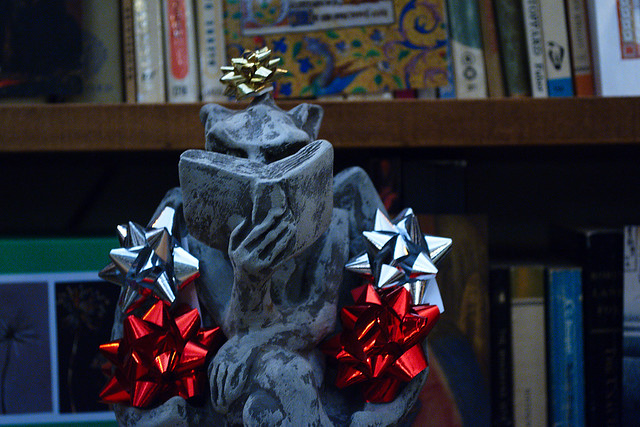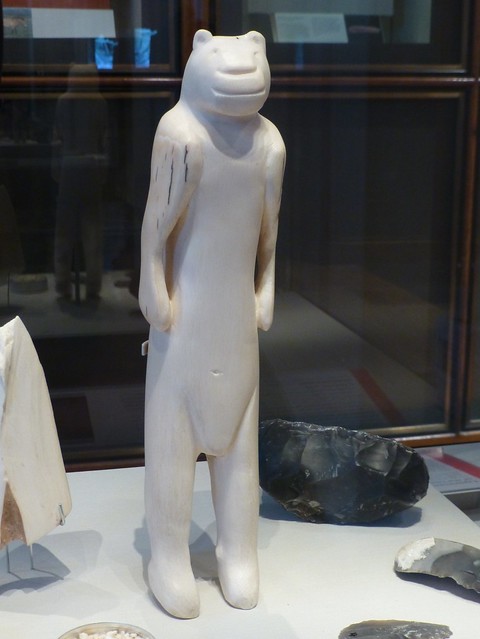The British Museum’s current large exhibition is about Ice Age Art, and we went to see it earlier this month (just before we went away on holiday in fact, which is why the delay in writing about it 🙂 ).
Context
Modern humans (ie Homo sapiens) migrated out of Africa from around 70,000 years ago, and have inhabited Europe since at least 40,000 years ago. At that time the world was in a warmer phase of the Ice Age (tho still colder than today), and the ice sheets left lots of space in Europe for people to live. By around 20,000 years ago the world had cooled down more, and the ice sheets advanced down into Europe before retreating again (and the Ice Age “ended” about 10,000 years ago). The exhibition is about the art that has been found in Europe from that time period, which is the oldest art known from Europe.
The Exhibition
The exhibition is arranged chronologically – so you start with some of the oldest pieces dating from nearly 40,000 years ago, and move to things that are a mere 10-15,000 years old and date back to only a short time before agriculture & civilisation start. It is also grouped by type in many cases, so you see several small statues of abstract women together or several small animal sculptures together. There’s a strong emphasis on how these things are made by people, just like us – I thought they did a good job of conveying that particularly by putting in some pieces of modern art in the same room. Like a sculpture by Henry Moore that’s got a similar feel & aesthetic to the curves of the 30,000 year old small female nudes.
One thing that’s very striking about the objects in the exhibition is that they are so well made – these are not “cave people banging rocks together”. These are for the most part the works of artists who are skilled at creating the carvings, and as good at representational or abstract art as any artist today. Human figures seem to’ve been mostly represented in an abstract or generalised fashion rather than being portraits, but the animal carvings tended to be representational and look very like the thing they were representing. Which is interesting because art seems to have arrived fully fledged – even the oldest pieces (like the 35,000 year old lion man statue for instance) are well made. Maybe this is sampling bias – obviously very little actually survives from such a long ago time, but do we also discard the “banging rocks together” level of experimentation because we don’t see it as art when we see it? The lion man, or the female figurines, or the horses etc etc are very obviously created and created as art so we know what we’re looking at when it’s found.
Most of the objects in the exhibition are small sculptures or tools – physical & three dimensional objects. Obviously we know of two dimensional art from the era, from cave paintings, but you can’t pick them up and move them to a museum. They did have a room with an audiovisual display of some of the cave art, which was a good addition – although I wasn’t keen on the way it was set up as you walked in from a door under the projection so you ended up facing the people watching it and it felt like to find a seat or place to stand you had to walk across people’s view. There was also some indication of other forms of art – like music. One of the objects on display was a small flute made from the rib of a bird (I think it was a vulture) – again it’s sophisticated, in that the holes have clearly been measured (there are faint orientation marks) and precisely placed. The exhibition suggested that the overall bias to small portable things is also probably a true reflection of the time. People during the Ice Age lived a nomadic lifestyle, so you needed to be able to pack up your belongings and move them with you. So even if some of your art is designed to stay in one place the more personal stuff needs to be small.
One striking thing through the whole exhibition was that the vast majority of the human representations were of women – I can only remember a couple that weren’t. In the earlier Ice Age these are nude figures of older women who’ve had children or who are pregnant, with breasts, stomachs & hips/bottom emphasised. Not in a sexualised way, but fertility is clearly part of it. The more recent ones (ie ~20,000 years ago) are also of younger more obviously “sexy” women. There’s an interesting video clip on the museum’s page about the exhibition where the curator & an artist discuss how these figurines seem to represent more the female gaze than the male gaze we’re more accustomed to think about female nudes via. Less “look at the tits & ass on that” and more about the physical experiences of being pregnant or whatever. Their conclusion is that possibly these figurines were made by women and were something to do with rites of passage (puberty, pregnancy, childbirth, motherhood etc) of women. But obviously we’ll never know.
Which last sentence neatly segues into the next thing I wanted to mention – I really liked the way the labelling was so clear about “we think this may’ve been used for that purpose but we don’t know”. Because we don’t, and can’t. The best we can do is to remember that these people were people just like us, and to think about how we’d use such things or what we’d make such things for. Some things must’ve been significant – like the lion man statue which would take ~800 hours to make with the tools of the time. That’s a major investment of time, so maybe it had some religious or spiritual importance. Or maybe this is one person’s life’s work of art that they did an hour at a time because they were an artist and that was what they felt a need to create? Other items looked less well made, some tools had pictures of animals etched into the surface by a less practiced & less artistic hand – was this someone making their spear straightener look more elegant/prettier/more their own by decorating it themself? Or was this important in a magical sense – that you drew your own bison on your own spear straightener because then you‘d catch bison with the spears you made? We don’t know & we can’t know, we can just guess because these were people.
This was a fascinating exhibition which both managed to remind you how old these things were, and how like us these people were. These objects come from a long period – three or four times the length of civilisation itself (not just our civilisation, but everything from the agricultural revolution onwards). And that’s mind-boggling. We think of a couple of hundred years ago as “history”, recent maybe, but history even so – people were different then, the past is a different country etc. We think of the Greeks & Romans as a long time ago, the Ancient Egyptians as longer still. But that’s all the last little bit of humankind – these pieces of Ice Age art are the representatives of the majority of human art in terms of time. And yet for all their age these people and their art are still recognisable – they just grew up in a different time and place.
The exhibition’s on till 26th May, and I’d definitely recommend a visit.
Other Stuff
Retail: Bought the book already (and definitely on my list to read). They had some very cool looking stuff, in particular a mug with a painting of a deer on it that became 3D to make the handle out of its head. We didn’t buy anything though.
Other Exhibits: Only a brief trot through the Egyptian rooms, with Ellen & Ady after we’d met up with them.
Other Things: As mentioned above, met Ellen in the museum by design, Ady by accident (well, we didn’t know for sure he was coming to the gig let alone where he’d meet us) and then Paul after we came out. Then off to a gig (about which more another time) via dinner at a place called Pasta Brown, which was rather nice even if they did take rather a long time to bring the bill when we were done.

